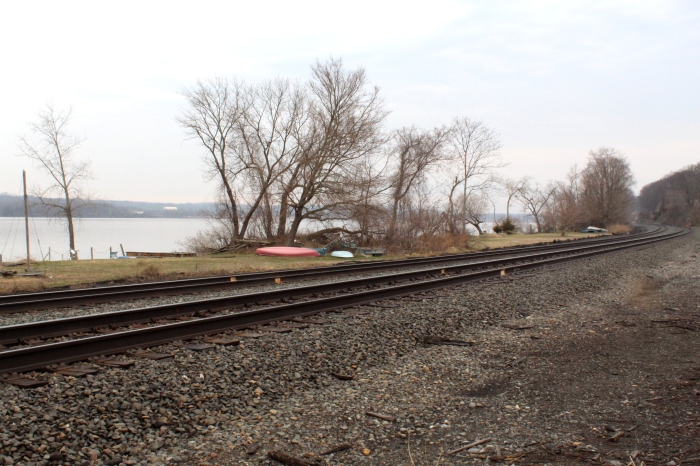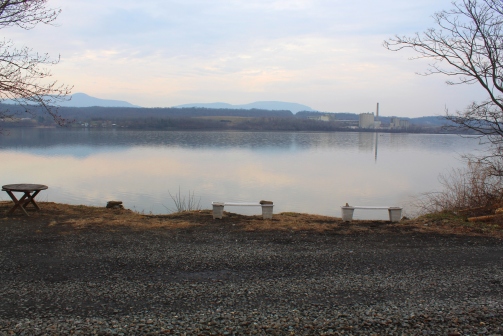 A group of Hudson River enthusiasts claims Amtrak’s plan to limit access to the river through a series of fences and gates is built on false pretenses.
A group of Hudson River enthusiasts claims Amtrak’s plan to limit access to the river through a series of fences and gates is built on false pretenses.
Amtrak’s proposal is meant “to keep pedestrians and vehicles out of harm’s way,” according to the plan, but the committee said government documents reveal there have been no accidents the barriers would have prevented.
Amtrak, a for-profit company with its majority owned by the federal government, wants to construct a mile-and-a-half of fencing on the east side of the Hudson between its tracks, which hug the river for most of their length, and the mainland. Since Amtrak controls the strip of land the tracks lie on, anyone crossing the tracks on their way to the river in all but a few official points is trespassing, according to Amtrak.
The fencing would be built in areas of Rhinebeck, Tivoli, Germantown, Stockport and Stuyvesant.
The plan also calls for a series of gates blocking access to an Amtrak maintenance road between the tracks and the river used by fishing enthusiasts.
The Germantown Waterfront Advisory Committee challenged Amtrak’s claim the barriers are for safety’s sake by submitting a Freedom of Information Law (FOIL) request to Amtrak requesting all reports of safety concerns and maintenance issues on a nine-mile stretch of tracks on the Dutchess-Columbia County border from 2010 to mid-2018.
For more on the plan, click here.
The Documents
Amtrak released 211 pages of reports to the Germantown Waterfront Committee in August after receiving the FOIL request in May, said William Shannon, the group’s spokesman.
The group was waiting to release the documents until Amtrak scheduled public information sessions on the project, which it had promised to do after controversy emerged about the project last spring, but when the group got word the sessions wouldn’t be held until 2019, they made the documents available to the media and released them online, according to Shannon.
Two people died on the nine-mile stretch of tracks from 2010-2018, the documents show, but Shannon said neither death would have been prevented by the fencing or gates.
The first occurred just before 11 a.m. on Oct. 29, 2014 when Minwella Kline, an Amtrak employee, was hit by a five-car passenger train in Germantown, according to an Amtrak Police report contained in the released documents.
Kline, who was assigned to the Hudson Rail Yard, was working with a contractor who was splicing wires along the tracks, according to the report. She told the contractor her legs had been cramping due to sitting in a vehicle for too long and took a walk along the tracks to stretch them before being hit, the report reads.
As an on-duty Amtrak employee, Klein was certainly not someone the proposal seeks to block from Amtrak property.
The second death is a bit more complicated.
A body was found the morning of Dec. 21, 2015 by workers inspecting the tracks in Germantown. There had been no reports of a train hitting anyone, according to the report.
The 78-year-old, who was in the process of being evicted from his apartment in the Bronx, had an extensive history of illegally hopping MTA trains in New York City, according to the report.

Benches along the Amtrak maintenance road in Germantown, which the rail company wants to block off with gates to stop its use by unauthorized vehicles.
The autopsy reported the “exact cause of death is hard to determine, but it appears the injuries were sustained by falling from a train rather than being struck/run over by a train,” according to the report, which suggested the equipment in question was a freight train headed north from New York City that passed through Germantown at about 3 a.m.
“I saw that as confirmation (that) he got on a freight train somewhere around New York City and was riding it for some mysterious reason,” Shannon said of the report’s findings.
“Technically he was trespassing on railroad property, but to us, the fences and the gates wouldn’t have prevented that one,” he continued.
There was also a report in the released documents showing a train had to slam on its breaks when the operator saw children playing on the tracks.
“That’s pretty serious,” Shannon said.
If people were consistently accessing the river over the tracks, they “could report if kids are doing stupid things,” he said. “Our argument is first, over the course of eight-and-a-half years, there are only a handful of serious incidents, and it’s not for sure if any of those would have been prevented by the fences or gates. It suggests people can use that area (safely).”
Safety on the Rest of the Tracks
The Germantown Waterfront Advisory Committee only examined the nine miles of track in Germantown and Tivoli, but the fencing is also proposed for areas in Stockport and Stuyvesant in Columbia County, and Rhinebeck in northern Dutchess County.
Statistics compiled by the Federal Railroad Administration are scant on details, including where and on what rail line fatalities occurred, but media reports shed light on two recent incidents along the tracks, one of which could have arguably been prevented by the proposed fencing.
The first incident, where a tow truck operator was hit and injured while parked on the tracks, dealing with an unrelated car accident, occurred in an area unrelated to the proposal, and at a legal rail crossing, according to The Register-Star.
A prior collision listed in the data could have arguably been avoided with the proposed fences, however.
The collision, which killed a Philmont man, happened on the tracks in Stockport, according to the Albany Times-Union, at a location Amtrak wants to erect a fence.
Amtrak’s Plan
The fencing would seek to funnel those trying to access the river to official crossings in some areas and block all pedestrian access in others, while the gates would mostly seek to block vehicles from driving along the Amtrak maintenance road located between the tracks and the river, according to the plan, which must be approved by the New York State Department of State (DOS) in order to move forward.
The river is regularly accessed via unofficial crossings, and docks, benches and canoes can be seen on the river’s shore at these points.
Bird-watchers, kayakers, joggers and swimmers access the river here, but the group most affected by the plan would be anglers, who use the maintenance road to hook bass and other fish.
The Amtrak proposal includes locked gates along this road to keep vehicles out.
Blowback from residents and town supervisors led the DOS to extend the comment period by 15 days until the end of last April.
A meeting set up by Congressman John Faso with Amtrak and attended by town supervisors and state legislators was held in May, and an additional meeting was held in August. Amtrak has promised to hold information sessions open to the public on the plans, but Shannon said those meeting would not be held until next year.
The committee and town supervisors have complained the details of the plans are sketchy and affected municipalities have not been included in the planning. They also question if emergency responders would have access to the maintenance road.
Emergency responders twice used the maintenance road during the eight-year period the documents covered, according to the committee, once for a police foot pursuit and once for a downed plane in the river.
The state received 302 written comments about the proposal during the comment period, as well as a petition with 108 signatures, according to the committee. Two still-active Change.org petitions have gathered more than 2,000 signatures.
Responding to a list of questions from The Other Hudson Valley, Amtrak emailed a statement saying the project “is still under review by Amtrak, NYSDOT (Department of Transportation), and NYSDOS (Department of State). Public Informational meetings have not been scheduled but will be announced in the future.”
The environmental advocacy group Scenic Hudson has come out against the project, arguing it limits access to the river, conflicting with New York’s coastal management policies.
The Germantown Waterfront Committee has said safety is a priority, but riparian enthusiasts not deterred by the new fences would simply access the river by more dangerous routes. The committee has looked into more sustainable solutions, such as building a pedestrian bridge near its waterfront.



Pingback: Alternative Proposed to Amtrak’s Plan Cutting Off Hudson Access
Pingback: Amtrak Pulls Plan to Fence Off Parts of Hudson River